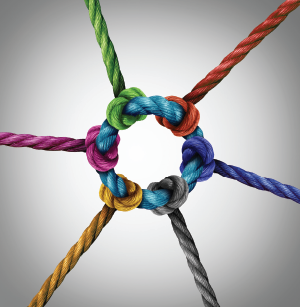
Lightspring/shutterstock.com
A faculty member at the University of California, San Francisco (UCSF) School of Medicine posed this question to a resident while attending rounds. Both were portraying a scene involving micro-aggression during Differences Matter, a three-day orientation for first-year medical students.
On the program’s first day, students are introduced to unconscious bias and micro-aggressions, which are dismissive or insensitive questions or phrases physicians unintentionally say to patients, students or trainees based on their age, gender, race, sexual orientation, ethnicity or religious background. Students then spend the next two days developing relationship-centered communication skills, such as how to greet patients respectfully and ask open-ended questions to help make each patient encounter more productive and emotionally comfortable.
“[Differences Matter] is designed to expose medical students to the UCSF culture of equity,” says Denise Davis, MD, clinical professor of medicine, specialist for diversity and general internist at UCSF School of Medicine. “We teach that bias is not a moral failing; it’s a habit of mind.”
No one—not researchers, scientists or clinicians—is immune to unconscious bias. These are social stereotypes that individuals across all professions form about other groups of people. Some schools are tackling unconscious bias head on and offering other diversity and inclusion training opportunities for faculty and medical students in hopes of producing better patient experiences and outcomes.
Multiple Training Layers
Medical schools are raising awareness about diversity and inclusion in many ways.
Back in 2015, UCSF also introduced a peer consultation group that targeted race relationships, language and culture for faculty, who met monthly for six months.
“These are people who want to improve their listening and communication skills across differences,” Dr. Davis says, adding that 12 out of more than 100 school faculty belonged to this voluntary group. “Through personal narratives, we were able to get beyond some of the limitations of our own knowledge about other people and groups and also did some case-based learning about how we could respond to differences in the classroom and in the clinic.”
That same year, Dr. Davis and another colleague from the American Academy on Communication in Healthcare introduced a voluntary mentoring program for faculty. During the two-hour workshop and subsequent booster session, the group reviews literature on the needs of minority medical students and trainees so faculty can better coach the school’s student mentors. So far, roughly 30 physicians have participated.
Still, there’s more work to be done. Dr. Davis says the school is developing a diverse group of medical student coaches, which is no small feat, because she says minorities represent only roughly 7% of medical faculty in the U.S.
“This has to begin with faculty,” she says. “We’re the ones teaching this curriculum. There must be open dialogue and discussions about how we’re approaching the topics of cultural competency and teaching students about the biases that we all bring into the room.”
About four years ago, Brookshield Laurent, DO, vice chair of the Department of Clinical Medicine at the NY Institute of Technology (NYIT) College of Osteopathic Medicine, revamped the culture competency component of the department’s medical curriculum.
Similar to observing micro-aggression scenarios, students watch video vignettes of physician–patient encounters that reveal physician biases. For example, a male physician enters the exam room and offers to shake hands with the female patient and her husband, who may be from the Middle East. But due to cultural disparities, the physician must direct his remarks to the husband, not the wife. Classroom discussions then follow, with students debating whether or not the interaction distracted the physician from giving the patient appropriate care.
Students also complete a virtual medicine and simulation course in which they engage with mock patients from different backgrounds, ask related questions, build rapport and prescribe needed care. Some also volunteer to perform these same tasks in real life at the student-run clinic that caters to an underserved area that supports a diverse population.
At Massachusetts General Hospital (MGH) in Boston, trainees, physicians and the hospital’s leadership participate in a variety of diversity and inclusion training opportunities, says Sherri-Ann Burnett-Bowie, MD, director of multicultural affairs for MGH’s department of medicine, who has been involved with the hospital’s diversity efforts since 2010.
She says learning occurs during grand rounds, noontime conferences, two-hour workshops, two-hour executive retreats and reflective sessions, which have included a facilitated panel, addressing employee questions and were live streamed throughout the hospital’s network. Mentoring programs are ongoing and may soon be expanded.
Across Boundaries
At some medical schools, diversity is a school-wide topic discussed throughout the year by both faculty and students.
Dr. Laurent at NYIT says diversity is among the topics addressed during faculty development discussions and simulated trainings with students. Faculty also offers tips on how to strengthen this part of the curriculum.
One strategy was to develop surveys that measure students’ behavior, attitude and comfort level before and after being exposed to unconscious bias. She says the surveys are currently being designed and will likely be conducted next year.
Meanwhile, increasing awareness of unconscious bias among medical students and faculty offers a healthy side effect—reducing health inequities, especially among minority patients.
“Multiple studies have come out on how the perception or biases I have of certain patients can determine how I talk to them and the care I give them,” says Dr. Laurent. “If we don’t make our students aware of that, we won’t provide good care or close the health disparity gap.”
Diversity initiatives for faculty and students must not only continue, but evolve, adds Dr. Burnett-Bowie, who serves in other roles at MGH and Harvard Medical School (HMS). At MGH, she’s also an associate director for the Center for Diversity and Inclusion and a member of the executive diversity and inclusion committee. At HMS, she is the faculty assistant dean of student affairs.
She says the importance of diversity and inclusion is understood and integral to all functions at MGH ranging from clinical care to community outreach. So much so that human resources and other hospital departments are either developing or have launched diversity initiatives for their own staff. However, the executive diversity and inclusion committee spent the last two years defining cross-fertilization strategies so that all departments can benefit from each other’s efforts.
Still, unconscious bias is a tough topic to address and often creates discomfort for people. She typically begins presentations on the subject by discussing her own biases or blind spots.
“It was and still continues to be something that many people struggle with,” Dr. Burnett-Bowie says, explaining that initially, some people get defensive and are reluctant to believe they can make insensitive comments. “Even if this is a difficult conversation for individuals to have within their respective communities, it’s still critically important. It’s a muscle we need to be exercising far more often.”
Carol Patton is a writer based in Las Vegas.


